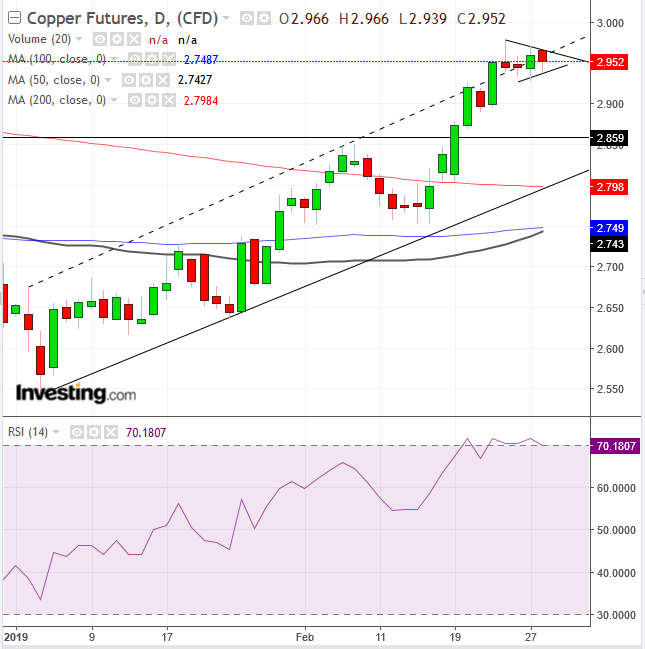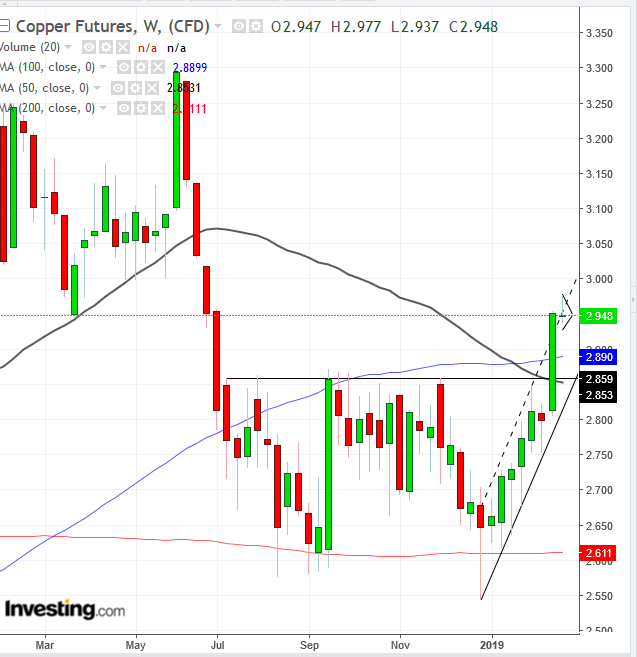The price of copper dropped earlier today after China reported disappointing manufacturing PMI readings for February. China buys 40% of the global market supply, so it makes sense that traders would respond by selling off the red metal. As China’s growth shrinks, so do copper prices. However, since then the metal has rebounded, paring the 0.68% earlier decline to just 0.27%, less than half the initial slide, as of the time of writing.
So who is buying copper, despite the PMI's warning signals about the Chinese economy? Before answering, it's important to note that the known fundamental cause for the rebound is falling supply, which is offsetting the outlook for lower demand. Then, a look at the chart will help demonstrate who the current buyers are.

The red metal has been trading within a clearly defined ascending channel since the beginning of the year, lagging the equity rally by just a week. A channel is made up of two lines: the bottom, demand line, and the top, supply line. That means whenever the price reached the channel bottom, demand kicked in, overcoming the supply at these levels and pushing up prices toward the top of the channel. There, waiting sellers increased sell orders and batted prices back down toward buyers.
Copper is set to close 5.7% higher for February amid supply concerns and earlier optimism over U.S.-China trade talks, making it the best month since December 2017. Between the Feb. 14 low of 2.753 and the Feb. 25 high of 2.977, the price gained 22.4 cents, or 8.14% in just 11 sessions.
That’s who's buying copper now—the traders who enjoyed the recent incredible rally of Feb. 14-Feb. 25. That 8% jump prompted them to take profits, catch their breath and decide on their next move.
The fact that prices are holding these gains, especially after today’s weak Chinese data, demonstrates sufficient demand to absorb all the supply at these levels. Therefore, an upside breakout would signal that demand is willing to increase risk and seek higher prices.
That’s when the earlier bulls will jump back in for another rally. Note, the pennant developed after prices penetrated the supply-line of the channel. That would be a good place for traders to sell. It would also be a good place for a pause, as other traders build positions, getting ready to push prices higher. We also understand the necessity for a consolidation here, when looking at the bigger picture.

Copper's weekly price met with the substantial resistance of the September 2017 - June 2018 lows. However, this is an appropriate time to appreciate the symmetry of the price map. Copper completed a double-bottom, starting in July, as it cut through the 50 and 100 WMA like butter, after the 200 WMA was an obvious support for the bottom. This double-bottom strengthens the case for our bullish argument, despite the panic spread by the headlines.
Back to the daily chart, the 50 DMA (black) is curving upward and set to overcome the 100 DMA (blue).
While we also see an overbought RSI—and curving down to boot—it is inevitable that after the biggest monthly jump in 14 months, the momentum factor within market dynamics would come into play. This explains the need for a consolidation, to allow for momentum, and give space to an overheating market to cool down.
Trading Strategies – Long Position Setup
Conservative traders should wait for a decisive upside breakout, including a 3% filter to avoid a bull trap. Then, they’d wait for a return move to retest the validity of the shift as part of an ongoing uptrend, with at least one long, green candle engulfing a red or small candle of either color.
Moderate traders may be content with a 2% penetration and wait for a pullback for a better entry, if not for proof of support, as explained above.
Aggressive traders should wait for more than the customary 1% upside breakout, to include a close above the 3.000 round psychological number, which would add to the resistance of the lows at the 2018 top.
